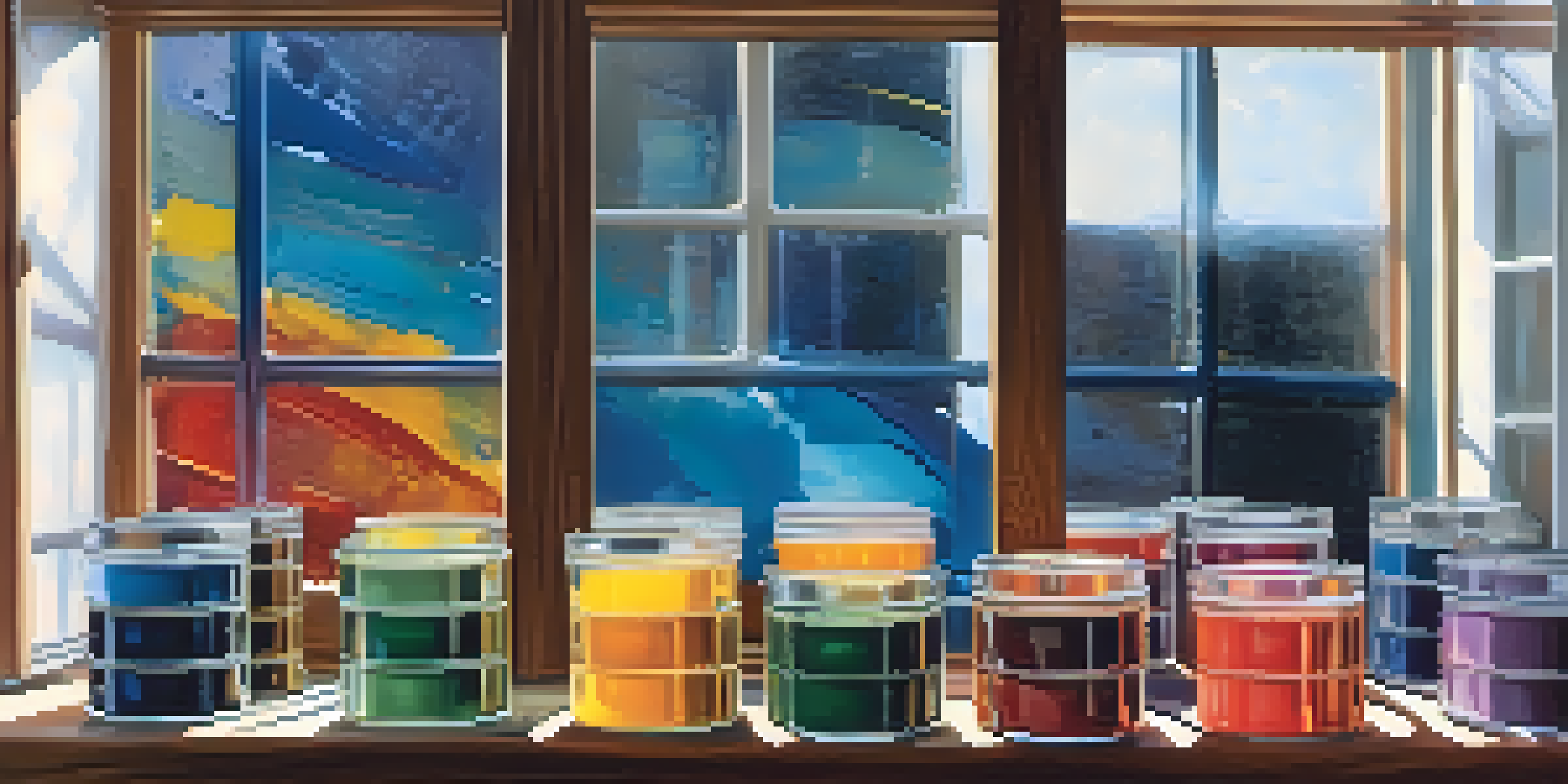Binders in Paint: The Role of Adhesives in Coating Forms

What Are Binders and Their Importance in Paint?
Binders are the essential components in paint that hold together the pigment particles, forming a cohesive film once the paint dries. They play a crucial role in the paint's adhesion to surfaces, durability, and overall performance. Without binders, paint would essentially be a mixture of color particles that would easily wash away or flake off.
Paint is only as good as its binder.
Think of binders as the glue that holds a team together. Just as glue ensures that pieces of a puzzle fit perfectly, binders enable the various components of paint to work in harmony. This is vital for applications ranging from artistic painting to industrial coatings.
In essence, binders not only enhance the visual appeal of paint but also determine how well it performs under various conditions. This makes understanding their role a fundamental aspect of paint formulation.
Types of Binders Used in Paint Formulations
There are several types of binders used in paint, each with unique properties and applications. Common examples include acrylics, vinyls, alkyds, and urethanes, each offering varying degrees of adhesion, flexibility, and resistance to environmental factors. The choice of binder often depends on the intended use of the paint, whether for indoor walls or outdoor structures.

For instance, acrylic binders are known for their excellent UV resistance and are widely used in exterior paints. On the other hand, alkyd binders provide a durable finish that is resistant to wear, making them ideal for high-traffic areas. This diversity allows manufacturers to tailor paints to specific conditions and requirements.
Binders are Key to Paint Performance
Binders hold pigment particles together, influencing adhesion, durability, and overall paint effectiveness.
Understanding these different types of binders helps consumers make informed choices about which paint products to use for their projects. By selecting the right binder, individuals can enhance the longevity and effectiveness of their chosen paint.
The Chemistry Behind Binders in Paint
The chemistry of binders involves complex polymer structures that provide the necessary adhesion and durability. As paint dries, the solvent evaporates, causing the binder to form a film that encapsulates the pigment particles. This film formation is crucial, as it determines how well the paint adheres to the surface and withstands environmental challenges.
Sustainability is no longer about doing less harm. It's about doing more good.
For example, the polymer chains in binders can interlock and create a strong network, enhancing the paint's resistance to scratches and wear. This chemical interaction is what makes the difference between a low-quality paint that chips easily and a premium paint that stands the test of time.
By understanding the chemistry behind binders, manufacturers can innovate and improve paint formulations, leading to better performance and more sustainable options in the market.
How Binders Affect Paint Performance
Binders significantly influence various performance characteristics of paint, such as adhesion, flexibility, and resistance to moisture and chemicals. A high-quality binder can enhance the paint's ability to stick to different surfaces, ensuring a smooth finish that lasts. Conversely, a poor binder can lead to peeling, bubbling, or fading over time.
For instance, in humid environments, moisture-resistant binders can prevent paint from bubbling or peeling, maintaining a beautiful finish. This adaptability makes binders a focal point in paint development, as manufacturers strive to create products that meet specific environmental demands.
Types of Binders Tailor Paint Use
Different binders like acrylics and alkyds provide unique properties that cater to various painting applications.
Ultimately, the performance of paint is a direct reflection of the quality and type of binder used, making it essential for consumers and professionals alike to consider these factors when selecting paint.
Environmental Considerations in Binder Selection
When choosing binders for paints, environmental impact is becoming an increasingly important consideration. Many manufacturers are now focusing on creating low-VOC (volatile organic compounds) binders that are less harmful to indoor air quality and the environment. This shift is not only beneficial for health but also aligns with a growing demand for sustainable products.
For example, water-based binders, such as those found in many acrylic paints, typically emit fewer VOCs compared to their solvent-based counterparts. This makes them a popular choice for both residential and commercial applications, especially in areas where air quality is a concern.
By prioritizing environmental considerations in binder selection, manufacturers can cater to eco-conscious consumers while also contributing to a healthier planet. This trend reflects a broader movement towards sustainability in the paint industry.
Binders in Specialty Coatings: A Closer Look
Specialty coatings, such as those used in automotive or marine applications, often require specific binders to meet unique performance demands. These binders must not only provide excellent adhesion but also withstand extreme conditions such as temperature fluctuations, moisture exposure, and UV radiation. This makes the choice of binder critical in achieving the desired durability and finish.
For example, epoxy binders are commonly used in automotive paints due to their superior adhesion and resistance to chemicals. Similarly, polyurethane binders are favored in marine coatings for their flexibility and resistance to harsh environmental conditions. These specialty coatings showcase how binders can be tailored to meet specific needs.
Sustainability Drives Binder Innovation
The shift towards low-VOC and bio-based binders reflects a growing commitment to environmental responsibility in paint formulations.
Understanding the role of binders in these applications allows manufacturers to innovate and create high-performance coatings that cater to niche markets. This specialization is vital in an industry that constantly seeks to improve and adapt.
Future Trends in Binder Development for Paints
The future of binders in paint is promising, with ongoing research and innovation aimed at improving performance and sustainability. Emerging technologies are focusing on bio-based binders, which utilize renewable resources to create more environmentally friendly options. This shift not only reduces reliance on petroleum-based products but also opens the door to new formulations that can enhance paint properties.
For instance, advancements in nanotechnology are enabling the development of binders with enhanced properties, such as increased strength and resistance to weathering. These innovations could lead to paints that last longer and require fewer resources for production, aligning with global sustainability goals.

As the paint industry evolves, staying informed about these trends will help consumers make educated choices. Embracing innovative binders today can lead to better performance and a more sustainable future in the world of coatings.